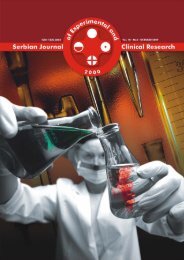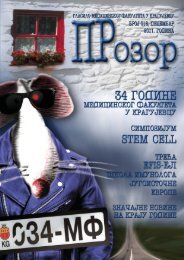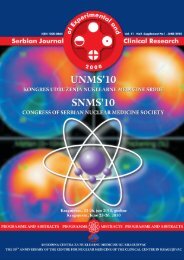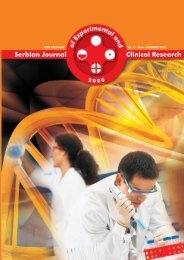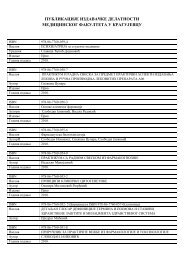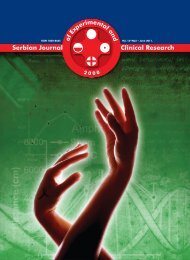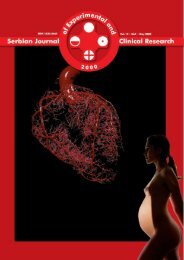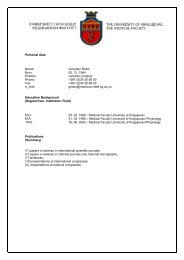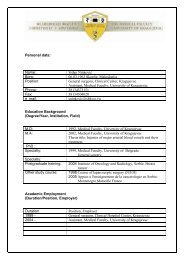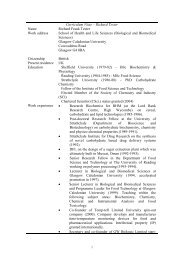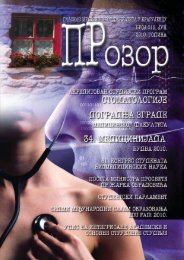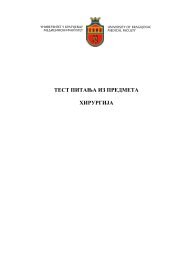neurotoxicity and mechanisms of induced hyperexcitability
neurotoxicity and mechanisms of induced hyperexcitability
neurotoxicity and mechanisms of induced hyperexcitability
Create successful ePaper yourself
Turn your PDF publications into a flip-book with our unique Google optimized e-Paper software.
pathologies could be a direct consequence <strong>of</strong> the inability<strong>of</strong> cerebral tissue to metabolise Hcy through the betaine<strong>and</strong> transsulfuration pathways, thereby favouring Hcy accumulationin the nervous system (18). High brain concentrations<strong>of</strong> either Hcy or its oxidised derivatives have beenshown to alter neurotransmission (19). The accumulation<strong>of</strong> homocysteine (at synapses or in the extracellular space)increases intracellular S-adenosylhomocysteine (SAH),which is a potent inhibitor <strong>of</strong> many methylation reactionsthat are vital for neurological function including the O-methylation <strong>of</strong> biogenic amines. Methylation <strong>of</strong> myelinbasic protein <strong>and</strong> reducing the synthesis <strong>of</strong> phosphatidylcholine, which can lead to blood-brain barrier (BBB) disruption,are a few pathological processes that are possiblein the absence <strong>of</strong> normal methylation patterns (20).It has been recently suggested that Hcy toxicity is aconsequence <strong>of</strong> its covalent binding to proteins, which interfereswith protein biosynthesis <strong>and</strong> decreases the normalphysiological activity <strong>of</strong> proteins. This modification<strong>of</strong> protein function is a process called homocysteinylation.Transthyretin is a plasma protein that is modified throughhomocysteinylation (3, 21). Other reports suggest that Hcyexerts its toxicity through the induction <strong>of</strong> endoplasmic reticulum(ER) stress. Increased intracellular Hcy concentrationsare associated with both the alteration <strong>of</strong> redox balance<strong>and</strong> post-translational protein modifications throughN- <strong>and</strong> S-homocysteinylation (22). Other studies suggestthat Hcy induces the expression <strong>of</strong> superoxide dismutasein endothelial cells, which leads to the consumption <strong>of</strong> NO<strong>and</strong> impairs endothelial vasorelaxation (23).HOMOCYSTEINE AND SEIZURESExperimental models <strong>of</strong> generalised clonic-tonic seizures<strong>induced</strong> by metaphit (1-[1(3-isothiocyanatophenyl)-cyclohexyl] piperidine) (24, 25) <strong>and</strong> lindane (γ-1,2,3,4,5,6-hexachlorocyclohexane) (26, 27) are widely used for thestudy <strong>of</strong> epilepsy <strong>and</strong> the preclinical evaluation <strong>of</strong> potentialantiepileptic treatments. In contrast to audiogenic epilepsy<strong>induced</strong> by metaphit with its typical <strong>and</strong> characteristicthree degrees <strong>of</strong> intensity, the lindane model is similar toHcy-<strong>induced</strong> epilepsy with a wide spectra <strong>of</strong> behaviouralmanifestations (e.g., hot plate reaction <strong>and</strong> Kangaroo position)incorporated into the rating scale from grades 0 - 4.Almost four decades ago, Sprince et al. (28) described thatelevated levels <strong>of</strong> homocysteine arising from excess dietarymethionine may induce epilepsy <strong>and</strong> lethality. The fact thatincreased homocysteine concentrations damage endothelialstructures <strong>and</strong> the blood coagulation system duringaging <strong>and</strong> in patients on antiepileptic drugs (29) justifiesthe attention directed toward the examination <strong>of</strong> homocysteine’sneural effects.Furthermore, experimental models <strong>of</strong> epilepsy may be<strong>induced</strong> by manipulations <strong>of</strong> γ-aminobuturic acid (e.g., bicuculline,corasol, picrotoxin <strong>and</strong> benzylpenicillin sodium)(30). In contrast, epilepsy can be <strong>induced</strong> by an oppositemechanism such as by increasing cerebral excitatory neurotransmission.There are several proposed <strong>mechanisms</strong>by which exposure to excess D,L-homocysteine or D,L-homocysteinethiolactone induce seizures. The most reactivenatural amino acid is homocysteic monocarboxylic, whichis sulphur-containing <strong>and</strong> its homocysteic sulphinic acidderivatives are excitatory amino acids that have been proposedas c<strong>and</strong>idates for brain excitatory neurotransmitters(31). However, answering the question as to whether D,Lhomocysteinethiolactone should be included in the list <strong>of</strong>epileptogenic factors according to behavioural <strong>and</strong> electrographicresponses will require additional studies <strong>and</strong>future human therapeutic trials. Increased levels <strong>of</strong> Hcy<strong>and</strong> its oxidised forms can provoke seizures by increasingactivation <strong>of</strong> certain neuronal receptors such as N-methyld-aspartate (NMDA), α-amino-3-hydroxy-5-methyl-4-isoxazolepropionate (AMPA)/kainate ionotropic glutamatereceptors or group I <strong>and</strong> group III metabotropic glutamatereceptors (5). All <strong>of</strong> these glutamate receptors areexpressed in hippocampal pyramidal cells <strong>and</strong> may directlyinduce or drive these cells over the threshold for excitotoxiccell death. Overstimulation <strong>of</strong> these receptors triggerscytoplasmic calcium pulses, Ca2 + influx <strong>and</strong> intraneuronalcalcium mobilisation in the presence <strong>of</strong> glycine (32).Increased cytosolic Ca2 + concentrations affect enzymeactivities <strong>and</strong> the synthesis <strong>of</strong> nitric oxide, which is a retrogrademessenger that overstimulates excitatory amino acidreceptors including glutamate, thereby lowering the convulsivethreshold (33). However, expression <strong>of</strong> the NMDAreceptor is not confined to neurons. Other cell types, includingendothelial cells from cerebral tissue, can expressthis receptor. Free radicals induce the up-regulation <strong>of</strong> theNR1 subunit <strong>of</strong> the NMDA receptor, thereby increasingthe susceptibility <strong>of</strong> cerebral endothelial cells to excitatoryamino acids, which can lead to blood brain barrier disruption(34). Microglia are also subject to the toxic effects<strong>of</strong> Hcy (35). Hcy can induce convulsions in adults <strong>and</strong> inimmature experimental animals through modulating theactivity <strong>of</strong> metabotropic glutamate receptors (mGluRs)(36). Kubova et al. (37) stated that the main epileptic phenomenonin homocysteine thiolactone treated rats wasemprosthotonic, flexion seizures, which are observed inyoung animals but never seen in rats older than 25 days.Homocysteine was shown to elicit minor (predominantlyclonic) <strong>and</strong> major (generalised tonic-clonic) seizures duringontogenesis in immature Wistar rats (36, 37). It seemsthat Hcy exerts a direct excitatory effect comparable to theaction <strong>of</strong> glutamate (17). In addition, Hcy has been shownto enhance either the release or uptake <strong>of</strong> other endogenousexcitatory amino acids (36).Classical anticonvulsants such as phenytoin, carbamazepine<strong>and</strong> valproic acid lower plasma folate levels <strong>and</strong> significantlyincrease homocysteine levels, which induces epileptogenesis<strong>and</strong> reduces the control <strong>of</strong> seizures in patients withepilepsy (38). On the other h<strong>and</strong>, increasing excitability withthis native amino acid further contributes to epileptogenesis<strong>and</strong> disturbs the balance between excitation <strong>and</strong> inhibition in5



